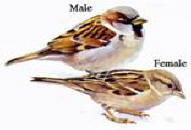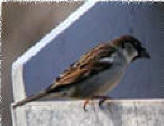![]()
![]()
![]()
| HOME |
| ABOUT US |
| SERVICES |
| BIRDS |
| BEES |
| PRODUCTS |
| PROJECTS |
| RESIDENTIAL |
| COMMERCIAL |
| OTHER PEST |
| FAQ |
| PMP's |
| LINKS |
| HELP WANTED |
| CONTACT US |
Southwestern States Commercial Service 1.877.828.2473
Sparrow Facts
Height/Weight
5"-6"
1oz
Life span
1-2yrs. Wild
to 10 yrs. captive
Flight speed
5-39 mph
Range
All states
rural-urban
Food
Seeds, Grains, Insects & Fruit
Habitat
Trees & Structures
Contact us today at 602-942-6550 - 480-969-2337 to see about scheduling an inspection of your property and see how we can help you stop all the noise and mess as well as protecting you, your family, employees and customers from possible slip & fall dangers or health hazards associated with pest birds that are roosting or nesting in and around your home or business.

Pigeon Sparrow Swallow Starling Woodpecker
House Sparrow Information

The House sparrow (Passer Domesticus) is the number two urban pest bird. Introduced as a species to North America, the house sparrow quickly spread across the country due to its lack of natural enemies and its adaptive traits. Its ability to nest in urban structures, eat urban scraps and a large breeding capacity are some of these adaptive traits. The House Sparrow is actually a member of the weaverbird family and not a true Sparrow. Weaverbirds create intricate nests and relative to their size, the largest nests in the bird world. Their legs and toes are favored for branch perching and their short conical bills are ideal for seed cracking. Their diet consists of seeds and grain, as well as fruits, vegetables, human table scraps and insects. They are boisterous, intelligent birds who roost in noisy flocks on branches of city trees, ivy covered walls and under eaves of houses.
Nesting
They build large nests relative to size which function as the center of all
activity. They prefer small enclosed places such as house shutters, drainage
piping, building rafters and corrugated metal siding. They will build a
spherical nest in a tree or another exposed place if they have no other
option. The building material will be sticks, with an inside lining of
grass, string, fabrics or straw. The nest will often hold several families.
Breeding
House sparrows only mate for a season. They average three broods per mating
season with each brood containing four to seven eggs with 20 offspring a year
average. Egg coloration will be white, pale blue or pale green with a few gray
or brown dots. If unchecked, a breeding pair can grow to over 2,000 birds in two
to three years.
Cycles
House Sparrows are not migratory, but in cold climates can show movement
between rural/suburban breeding sites and warmer winter
 roosting
sites in the city. House Sparrows are aggressive birds and will often force
out other birds from their territories. They are flocking birds and will
gather in the thousands to take over feeding and roosting areas.
roosting
sites in the city. House Sparrows are aggressive birds and will often force
out other birds from their territories. They are flocking birds and will
gather in the thousands to take over feeding and roosting areas.
Damage
House Sparrows are often a nuisance in urban areas like
manufacturing and food processing plants. Gutters and drainage pipes clogged
with sparrow nests can backup and cause extensive water damage and fires
have been attributed to electrical shorts caused by machinery housing
sparrow nests. Lastly, feces buildup can lead to structural damage from the
uric acid in droppings, plus the bacteria, fungal agents and parasites in
the feces also pose a health risk.
Control
The most effective method of control is to exclude sparrows from the area
with 3/4" StealthNet, or metal hardware cloth
making sure there are no gaps or crevices for the birds to pass through. The
only ledge deterrent systems that are truly effective against sparrows are
electrified ledge systems that use an intermittent pulse like
Bird-Shock or
Birdbuffer system. New 2-chambered Sparrow Traps are quite effective at
trapping small quantities of sparrows. The best trap has an elevated second
chamber that keeps the birds happy and so content that they actually sing,
attracting others to the trap. When practical, the trapping program should
be combined with a nest removal program that will greatly reduce the
population over time. Along with trapping, mist nets can be installed in the
flight paths by certified personnel to capture these birds in
enclosed areas. A new technique that has found some success for moving
populations is to fog (hazer) problem areas with
ReJeX-iT. This method is
most commonly applied when sparrows gather in flocks. Sparrows generally do
not react to audio and visual products except occasionally in areas to which
they are not very committed (new to area).
Legal Status
Contact us today for all your sparrow control or exclusion needs
Copyright © 2004 Arizona Wings-N-Stings All rights reserved. Revised: 10/09/10.
